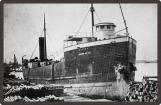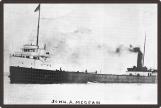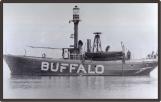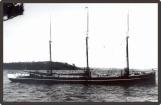14
HydrusEarly 20th Century
 Credits:
Credits:"Shipwrecks of the Great Lakes" (Book), Paul Hancock, PRC Publishing Ltd, London
Huron County Museum, Goderich, Ontario, Canada
15
The Hydrus was built in 1903 by the Interlake Steamship Company in Lorain, Ohio and owned by the Interlake Steamship Company of Cleveland, Ohio. She was originally named the R.E. Shuck but was renamed as the Hydrus in 1910. The Hydrus was 416 feet long with a beam of 52 feet. Her net tonnage was 3, 380 and her gross tonnage was 4, 707. One of her fleetmates was the Argus.On November 8th, the Hydrus was on Lake Superior making her way through the beginnings of the storm when she reached Sault St. Marie. It is believed that the Captain thought the worst of the storm to be over and continued south to Lake Huron. The Hydrus was eventually overcome by the storm and is believed to have been attempting to make it to the St,. Clair River for shelter. She sank near Lexington, Michigan, taking all 28 crew members with her.
The wreck of the Hydrus has not yet been discovered.
16
Regina20th Century
 Credits:
Credits:"Shipwrecks of the Great Lakes" (Book), Paul Hancock, PRC Publishing Ltd, London
Huron County Museum, Goderich, Ontario, Canada
18
The Regina was built in 1907 in Dumbarton, Scotland by A. McMillan and Son and owned by the Canada Interlake Company. She was 249 feet long with a beam of 42.5 feet. Her net tonnage was 1, 956 and gross tonnage was 2, 957.On November 9, 1913 the Regina was struggling through the storm. She sank, taking all 25 crew memebers with her.
In the days following the storm, crew members of the Charles S. Price washed ashore near Sarnia wearing life preservers from the Regina, leading many to believe that both ships had collided. When the Price's hull was looked at in the days following the storm, there was no evidence of a collision. The theory was further put to rest when the Regina was discovered in the late 1980's was found off the shore of Lexington, Michigan in 1987. No evidence of a collison was found on the wreck of the Regina. Some now believe that as the Charles S. Price was sinking, the Regina was close enough to her to rescue her crew and this is why life preservers from the Regina were found on sailors from the Charles S. Price.
The wreck of the Regina has been part of a marine archaeology project sponsered by the State of Michigan.
19
James Carruthers1913
 Credits:
Credits:"Shipwrecks of the Great Lakes" (Book), Paul Hancock, PRC Publishing Ltd, London
Huron County Museum, Goderich, Ontario, Canada
20
The James Carruthers was built in 1913 by Collingwood Ship Building Company in Collingwood, Ontario. She was owned by the St. Lawrence & Chicago Steam Navigation Company of Toronto, Ontario. The James Carruthers was 529 feet long with a beam of 58 feet. Her net tonnage was 5, 606 and her gross tonnage was 7, 862.The Carruthers was the newest ship on the Great Lakes at the time of the Great Storm, having been launched on May 22, 1913. She was also the largest Canadian vessel on the Great Lakes at the time of the storm. She sank on November 9th, taking all 25 crew members with her.
The wreck of the Carruthers was reported found north Kincardine in the late 1980's but this has yet to be confirmed.
22
The John A. McGean was built in 1908 by the American Shipbuilding Company in Lorain, Ohio and was owned by the Pioneer Steamship Company of Cleveland, Ohio. She was 432 feet long with a beam of 52 feet and a net tonnage of 3,777; her gross tonnage was 5,100.The John A. McGean was known as an "unsinkable" ship. She last sighted on November 7, 1913 off Tawas Point heading for De Tour. She is believed to have sank on November 8th taking all 23 crew with her.
In 1985, the wreck of the John A. McGean was found in Lake Huron just off Port Hope, Michigan.
23
The Howard M. Hanna, Jr, was built in 1906 by the American Shipbuilding Company in Cleveland, Ohio and was owned by the Hanna Transit Company of Cleveland, Ohio. She was 480 feet long with a net tonnage of 3,789 and gross tonnage of 5,667.On the morning of November 9th, the Howard M. Hanna entered Lake Huron in surprisingly clear weather. By noon, however, the storm had returned and in the afternoon, the Howard M. Hanna was sailing through a very violent gale. During this time, she was driven aground near Port Aux Barques, Michigan in Lake Huron. Her entire crew was rescued.
Originally, she was believed to be a total loss but in 1914, she was re-floated. The Howard M. Hanna continued sailing on the Great Lakes until she was finally scrapped in the late 1980's.



